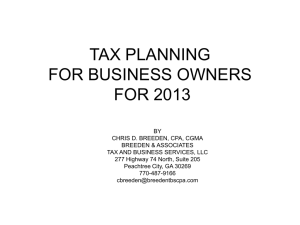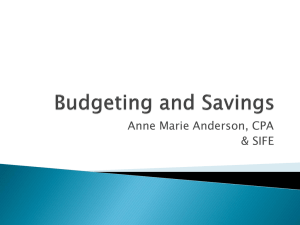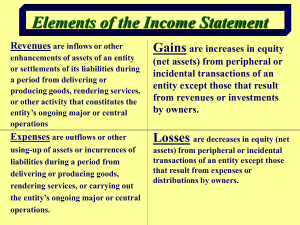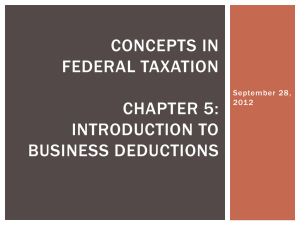Taxes for Real Estate Agents
advertisement
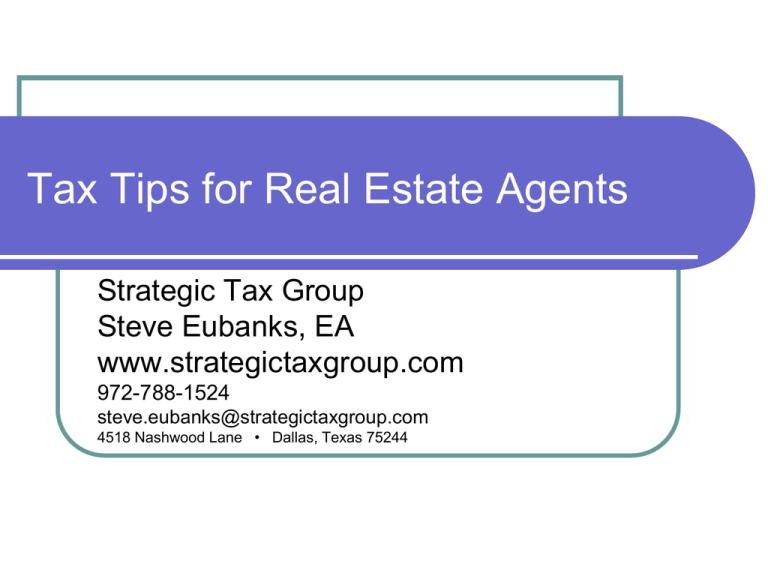
Tax Tips for Real Estate Agents Strategic Tax Group Steve Eubanks, EA www.strategictaxgroup.com 972-788-1524 steve.eubanks@strategictaxgroup.com 4518 Nashwood Lane • Dallas, Texas 75244 Steve Eubanks, EA (Enrolled Agent) A tax professional since 1986. BBA and MBA in Finance. Licensed by the U.S. Department of the Treasury to represent taxpayers before all administrative levels of the Internal Revenue Service (IRS), including examination, collection and appeals functions as Enrolled Agent. Enrolled Agents adhere to a code of ethics and professional conduct and are required by IRS to take Continuing Professional Education. Provide tax preparation, representation, tax planning and other financial services to individual and business taxpayers. Introduction Licensed Real Estate Agents IRS ruling Statutory NonEmployee Independent Contractor. Treated as Self-employed. Substantially all payments for their services relates directly to sales or output rather than hours worked. Their services are performed under a written contract providing that they will not be treated as employees for Federal Tax purposes. Form 1040, Schedule C (Profit & Loss) reporting for Real Estate Agents as Sole Proprietorships Schedule C RE Agents National Average Expenses National Average of Expenses as a Percentage of Income Advertising – 4.89% Car Expenses – 8.81% Commissions – 6.49% Depreciation – 2.45% Other Expenses – 10.49% Business Use of Home – 1.09% Total Expenses – 54.43% Common Expenses Advertising Costs: Signs, newspaper advertising, flyers, online advertising, post cards, promotional materials, and anything else that was used to market your business may be deductible. Professional Fees: Your MLS Board Dues, Realtor Dues, Renewal fees with your state board, Errors & Ommissions Insurance, and any other professional fees you incur may also be deductible. Education Materials: Any continuing education classes or seminars, books, magazines, etc. Client Gifts: New home or closing gifts for your clients. For tax purposes, you are allowed a deductions for gifts valued at up to $25 per person ($50 per couple). Items advertising your business would not be considered gifts. Office Equipment: Office equipment can include desk fees if you have them at your office, computer/software, phone fees (including cell phone), cameras, office supplies, and anything else related to necessities of running your office. And More…… Meals and Entertainment Meals, sports tickets, and other entertaiment. Must have documentation for the expense, including statement of the business purpose, names of the persons being entertained, date and location. Generally only 50 percent of business meal and entertainment expenses can be deducted. Must discuss business either before, during or after entertainment. Car/Driving Expenses Car/Driving Expenses: This is an obvious one most agents remember but many often get confused about how much mileage they can deduct or how to separate “personal” and “business use”. Actual Expenses – You may deduct the actual expenses of operating your car for business. This includes gas, insurance, repairs, maintenance, license, and depreciation. Standard Mileage Rate – You simply multiply your business miles driven during the year by the IRS standard rate for the year. Other Expenses – Some other auto expenses you are allowed for either method are parking fees, tolls, interest expense. AAA Average Cost 2008 2009 the rate is 55 cents per mile. 2010 the rate is 50 cents per mile. Medium Sedan driven 15,000 miles - 54 cents per mile Large Sedan driven 15,000 miles – 65.8 cents per mile Track Mileage Total miles (business and personal) Business miles Business Use of Home (Form 8829) To deduct expenses for business use of the home, part of your home must be used regularly and exclusively as one of the following: The principal place of business for your trade or business; The place where you meet and deal with your patients, clients, or customers in the normal course of your trade or business; or In connection with your trade or business, if you use a separate structure that is not attached to your home. Where the exclusive use requirement applies, you cannot deduct business expenses for any part of your home that you use for both personal and business purposes. For example, if you are an real estate agent and use the den of your home to make appointments and also for personal purposes, you may not deduct any business–use–of–your–home expenses. Further, under the principal-place-ofbusiness test, you must determine that your home is the principal place of your trade or business after considering where your most important activities are performed and most of your time is spent, in order to deduct expenses for the business use of your home. Deductible expenses for business use of your home include the business portion of real estate taxes, deductible mortgage interest, rent, casualty losses, utilities, insurance, depreciation, maintenance and repairs. You may not deduct expenses for lawn care in general or for painting a room not used for business. Record Keeping Record Keeping System Filing system for receipts and documents Paper Electronic Bookkeeping system Quickbooks (Simple, Pro, Premier) Spreadsheet (www.strategictaxgroup.com) Notebook (paper) Record weekly, bimonthly, monthly, quarterly Retirement Accounts SIMPLE IRA SEP 20% of SE income or $49,000 Simple to establish and administer Keogh $11,500 contribution limit 20% of SE income or generally $49,000 Can be designated a profit-sharing plan or a defined benefit plan. Generally requires a professional to set up. Solo 401(k) $49,0000 High contribution limits mean you can lower your tax bills and generate more tax-deferred earnings for your retirement. Estimated Tax Payments Due Dates Underpayment Penalty April 15 June 15 September 15 January 15 If you do not pay the proper amount of quarterly payments, Or make the payments late Your should equal the smaller of: 90% of the tax to be shown on your current year tax return, or 100% of the tax shown on your prior year tax return. Each estimated payment should be 25% of the total amount. Questions?

